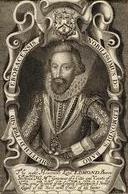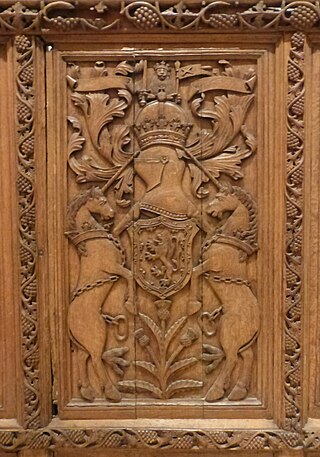Related Research Articles

Duke of Marlborough is a title in the Peerage of England. It was created by Queen Anne in 1702 for John Churchill, 1st Earl of Marlborough (1650–1722), the noted military leader. In historical texts, unqualified use of the title typically refers to the 1st Duke. The name of the dukedom refers to Marlborough in Wiltshire.

Marquess of Normanby is a title that has been created twice, once in the Peerage of England and once in the Peerage of the United Kingdom. The first creation came in 1694 in the Peerage of England in favour of John Sheffield, 3rd Earl of Mulgrave. He was a notable Tory politician of the late Stuart period, who served under Queen Anne as Lord Privy Seal and Lord President of the Council. In 1703 this first Marquess of Normanby was further honoured when he was made Duke of Buckingham and Normanby. These titles became extinct on the death of the 2nd Duke in 1735.

Duke of Atholl, named for Atholl in Scotland, is a title in the Peerage of Scotland held by the head of Clan Murray. It was created by Queen Anne in 1703 for John Murray, 2nd Marquess of Atholl, with a special remainder to the heir male of his father, the 1st Marquess.

The Lord Steward or Lord Steward of the Household is an official of the Royal Household in England. He is always a peer. Until 1924, he was always a member of the Government. Until 1782, the office was one of considerable political importance and carried Cabinet rank.

The title Earl of Mulgrave has been created twice. The first time as a title in the Peerage of England and the second time as a Peerage of the United Kingdom.

The office of Keeper of the Privy Seal of Scotland, one of the Great Officers of State, first appears in the reign of David II. After the Act of Union 1707 its holder was normally a peer, like the Keeper of the Great Seal. The office has remained unfilled since the death of Gavin Campbell, 1st Marquess of Breadalbane in 1922.
There has been a Lord Lieutenant of Buckinghamshire almost continuously since the position was created by King Henry VIII in 1535. The only exception to this was the English Civil War and English Interregnum between 1643 and 1660 when there was no king to support the Lieutenancy. The following list consists of all known holders of the position: earlier records have been lost and so a complete list is not possible. Since 1702, all Lord Lieutenants have also been Custos Rotulorum of Buckinghamshire.
This is a list of people who have served as Lord Lieutenant for the East Riding of Yorkshire. The office was established after the English Restoration in 1660, when a Lord Lieutenant was appointed for each Riding of Yorkshire. Since 1721, all Lord Lieutenants have also been Custos Rotulorum of the East Riding of Yorkshire, and for part of the period also Lieutenants of the Town and County of the Town of Kingston upon Hull. It was abolished on 31 March 1974 with the creation of the county of Humberside, but was re-created upon the abolition of Humberside on 1 April 1996.
This is a list of people who have served as Lord Lieutenant of Durham.
This is an incomplete list of people who have served as Lord Lieutenant of Somerset. Since 1714, all Lord Lieutenants have also been Custos Rotulorum of Somerset.
The post of Lord Lieutenant of the North Riding of Yorkshire was created in 1660, at the Restoration. It was abolished on 31 March 1974, and replaced with the office of Lord Lieutenant of North Yorkshire. From 1782 until 1974, all Lords Lieutenant were also Custos Rotulorum of the North Riding of Yorkshire.
Gentleman of the Bedchamber was a title in the Royal Household of the Kingdom of England from the 11th century, later used also in the Kingdom of Great Britain. A Lord of the Bedchamber was a courtier in the Royal Household; the term being first used in 1718. The duties of the Lords and Gentlemen of the Bedchamber originally consisted of assisting the monarch with dressing, waiting on him when he ate, guarding access to his bedchamber and closet and providing companionship. Such functions became less important over time, but provided proximity to the monarch; the holders were thus trusted confidants and often extremely powerful. The offices were in the gift of The Crown and were originally sworn by Royal Warrant directed to the Lord Chamberlain.

Brooks's is a gentlemen's club in St James's Street, London. It is one of the oldest and most exclusive gentlemen's clubs in the world.
References
- 1 2 3 4 5 6 7 8 9 10 11 12 13 14 15 "No. 2028". The London Gazette . 23 April 1685. p. 1.
- 1 2 3 4 5 6 7 8 9 10 11 12 13 14 15 "No. 2444". The London Gazette . 11–15 April 1689. p. 1.
- ↑ "No. 6614". The London Gazette . 10–14 October 1727. pp. 1–4.a.a.
- ↑ "No. 34453". The London Gazette (Supplement). 10 November 1937. p. 7050.
- 1 2 "No. 10142". The London Gazette . 22 September 1761. p. 4.
- ↑ "No. 17732". The London Gazette . 3 August 1821. p. 1607.
- ↑ "No. 18848". The London Gazette . 13 September 1831. p. 1868.
- ↑ "No. 19632". The London Gazette . 4 July 1838. p. 1517.
- ↑ "No. 27489". The London Gazette (Supplement). 28 October 1902. p. 6874.
- ↑ "No. 28535". The London Gazette (Supplement). 26 September 1911. p. 7099.
- ↑ "No. 34453". The London Gazette (Supplement). 10 November 1937. p. 7055.
- ↑ "No. 40020". The London Gazette (Supplement). 17 November 1953. p. 6250.
- ↑ "No. 17732". The London Gazette . 3 August 1821. p. 1608.
- ↑ "No. 18848". The London Gazette . 13 September 1831. p. 1869.
- ↑ "No. 19632". The London Gazette . 4 July 1838. p. 1518.
- ↑ "No. 27489". The London Gazette (Supplement). 28 October 1902. p. 6875.
- ↑ "No. 28535". The London Gazette (Supplement). 26 September 1911. p. 7100.
- ↑ "No. 34453". The London Gazette (Supplement). 10 November 1937. p. 7056.
- 1 2 3 4 5 'Hundred of Wayland: Scoulton', An Essay towards a Topographical History of the County of Norfolk: volume 2 (1805), pp. 344-348. URL: http://www.british-history.ac.uk/report.aspx?compid=78077 Date accessed: 5 March 2011.
- 1 2 3 "(A)bergavenny, Baron (E, 1450 – abeyant 1762)". Archived from the original on 6 May 2012. Retrieved 6 May 2012.
- ↑ "(A)bergavenny, Baron (E, after 1662 – abeyant 1833)". Archived from the original on 31 March 2012. Retrieved 31 March 2012.